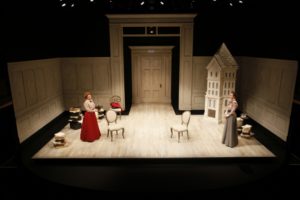When Henrik Ibsen wrote A Doll’s House in the 1870s, he raised shockingly progressive and controversial questions about marriage, motherhood, and women’s societal roles. When the central character, Nora, chose to leave her marriage and children at the end of the play, it was a door slam for gender equality.
In 2017, playwright Lucas Hnath brought the characters back in A Doll’s House, Part 2to examine the aftermath. The second part of the story takes place 15 years after the original, and, according to Belfry Theatre artistic director Michael Shamata, audience members don’t have to have seen the first play to understand the second.

“It’s recapped, in a kind of way, during the show. There’s enough exposition in the first scenes that the audience would kind of figure out what would happen,” says Shamata. “But the main thing is, at the end of A Doll’s House—the original—Nora, the wife,realizes that she and her husband don’t really have a real relationship, they’re both kind of playing roles, and she realizes that she needs to leave, and find out who she is, and find out what the world is really all about. So, she leaves her husband and her three children, and walks out.”
The Belfry chose A Doll’s House, Part 2for many reasons to be its 2018-2019 opening production, one reason being Shamata’s love of the script and appreciation for Hnath’s work.
“[Hnath]felt like the conversation had not been completed, that the conversation that Ibsen started about marriage, that there was more conversation to be had,” says Shamata. “So, he brings Nora back after 15 years of being absent, and partly she confronts the damage that she created—the mess that she left behind by leaving—to the three other characters in the play.”
The fact that the complexities and nuances of marriage are as true now as they were in the 1800s is one of the most exciting aspects of the play for Shamata, who says that the original ending of Ibsen’s play was deemed too shocking and changed in several countries because in the 1800s people couldn’t fathom the idea of a woman leaving her children; Shamata believes this notion still holds true in today’s society.
“The idea of a woman abandoning her children is still considered… it’s just not something that people do,” says Shamata.
This blending of two time periods allows A Doll’s House, Part 2to examine the issues of relationships and equality through a modern lens.
“That’s exactly what the playwright set out to do—write a play that’s in period costume, the language to a certain extent feels modern, feels contemporary, and the issues feel totally contemporary, but it could be a period piece,” says Shamata.
Past all its intricacies, at the heart of the show is a family with incredibly complex issues, and getting to the truth of that is one of the biggest challenges of the production.
“What’s really exciting is when it feels like people talking like people who have a lot of history, but haven’t seen each other for a long time,” says Shamata. “So there’s all this kind of baggage, and there’s also a lot of catch-up, and making sure that we all have our perspectives straight for each character, so that we all remember the same events but we have our own interpretation of them. It’s kind like when you see family at Christmas, and don’t see them in between… You know them, but you’ve missed a whole year of their lives and what’s happened to them.”
A Doll’s House, Part 2
The Belfry Theatre
Until Sunday, October 14
belfry.bc.ca
